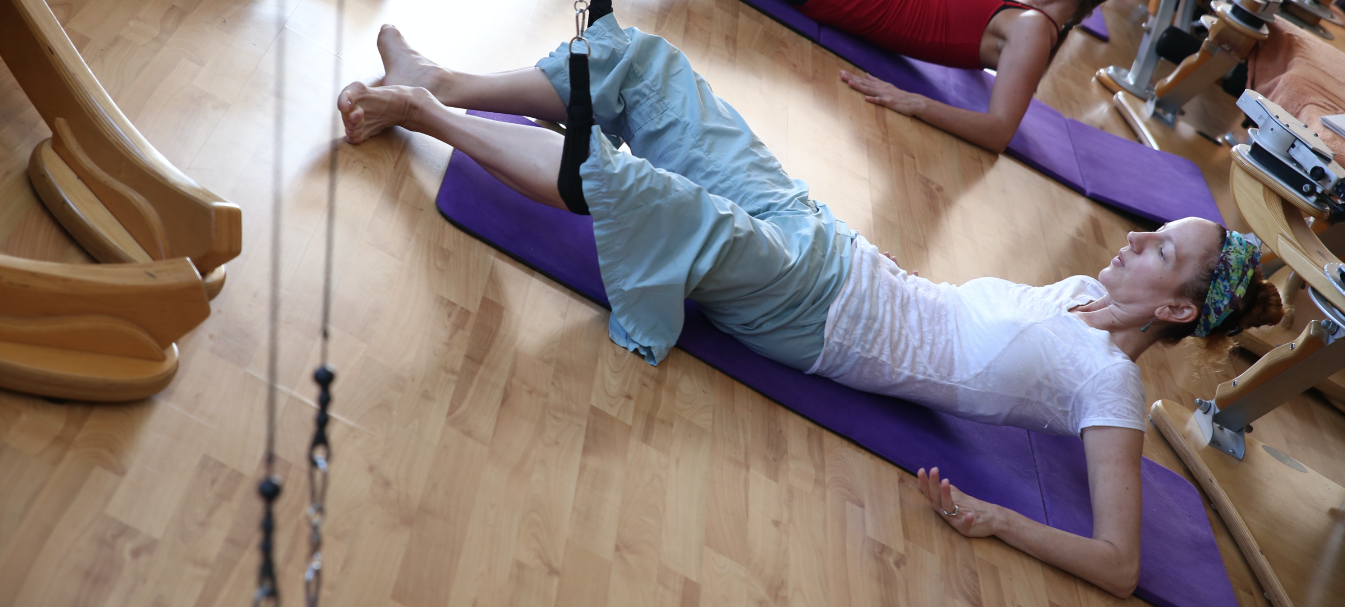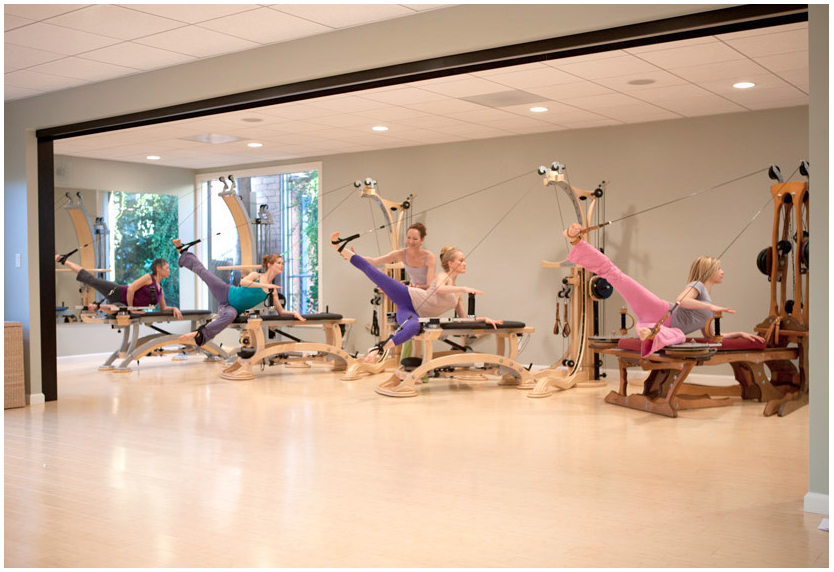The Hip Is A Messenger!
Blog Content // October 24, 2017
By Lisa Marie, GYROTONIC® and GYROKINESIS® Master Trainer
Goodwin Studios, Owner
https://www.goodwinstudiosllc.com/
Why I chose to enter into the never-ending investigation of the health and wellness industry was primarily due to the discoveries my own body was offering me. After doing and teaching the work for 15 years, my quality of life was being affected due to old dancing injuries accumulated over the years.
In 2005, after much research, I underwent arthroscopic hip surgery. Under the knife, the surgeon found that I had both anterior and posterior labral tears as well as frayed ligamentum teres.

Photo provided by Gyrotonic Headquarters
At the time of my surgery, there were not many surgeons performing arthroscopic surgeries on the hip. There were a few in the US who had done more than 2,000 surgeries, and they were actually training other surgeons how to perform it. Because the options for this were so limited, the aftercare, and even physical therapy before and after an arthroscopic hip surgery, were extremely limited.
Knowing that I wanted to return to dancing, teaching, and living comfortably in my body for many years to come, I took it upon myself to use this experience to learn more. The path I was on was an opportunity to gain knowledge and understanding, and I was determined to learn as much as I could so that I would be able to share this new information with my future clients and teachers.
What I learned along the way to better health
There are some key things that I have learned along the way to better health. To begin, the hip in particular can be a great messenger. Being at the center of our bodies, it sends messages to the spine above, and to the legs below.
Secondly, the GYROTONIC® methodology holds a unique and effective approach to acknowledging that hip issues are not about the hip alone, but that they are full body experiences. The Gyrotonic Method changes dysfunctional messages, which may be the cause of much pain, to more healthy and functional ways of moving.

Photo provided by Lisa Marie Goodwin
What to watch for with hip issues
Some things to watch for with hip issues include:
· Lower back instability
· Shoulder issues
· Cervical spine issues
· Knee issues and tracking
· Feet and ankles
Working with a hip injury
When working with a hip injury, one of the first things we want to ask is how the injury is affecting quality of life. Then you can go on the journey of working to enhance quality of life and increase longevity, so that you can do things and move in ways that bring joy and pleasure.
Specifically, releasing, igniting, connecting, and strengthening are all an integral part of rediscovering how to improve hip injuries and live freely and fully within our bodies.
Releasing
We want to accomplish releasing the congested region. The idea is to allow the body to let go of tensions so that we may begin to reestablish new and healthier functional movement patterns.
In targeting hip pain, we can release the posterior pelvic floor and deep external rotators as well as the larger gluteal muscles. But we must not forget to release the front of the hips, primarily being the illiacus and psoas. This can be done in simple ways such as using balls and foam rollers. As of late, I am liking the Alpha balls (medium size), but tennis balls work just as well.
If lying on the floor is not an option, then you can release the back of the hips while standing against a wall with the ball behind your hips and glutes.
Passive treatments that may help the release of the tight areas include acupuncture, cupping, and massage.
Igniting
The Gyrotonic Method inspires optimal function of movement. It is unique in that it allows the body to explore three-dimensional movement and can support this movement by adding traction, or guidance, via the machines.
We are then able to teach specific exercises focusing on the glut medius, glut minimus and the supportive part of the glut maximus around the sacrum. Traction, length, and strength are combined to create a well-supported and integrated body.
Connecting
If you have been in pain, then your body has most likely been creating other compensating movement patterns. It’s time to learn new movement patterns so that the body can begin to heal and unwind from the trauma, permitting the nervous system, visceral system, fascial body, spirit, and mind to return to ease and harmony.
For example, learning to move your leg from the hip with the hamstrings and psoas working synergistically while lessening the hip flexors and quadriceps from over firing. Often this can be established in a supine position with the feet up on a wall. This not only helps to decompress the spine, but also assists the femoral head to glide more posterior in the acetabulum (hip socket).
Another example is sliding a leg up the wall with attention to the hamstrings and psoas engaged and extending the leg up the wall and lowering it. While doing this, focus in on the deep external rotating muscles (in the Gyrotonic methodology we often refer to them as the “wrapping” muscles).
Four-point position movements are not only helpful in gliding the femoral head deep into the hip socket, but they are also usually quite safe.
Strengthening
There are many Gyrotonic movements that can help assist in creating blood flow into the acetabulum, as well as strengthen the deep supportive gluteals and hamstrings and create pelvic and lower back stability.
Home routines
A personalized home routine is of daily exercises that include release work, stretches, and strengthening that are created specifically for the client. This also helps lift one’s spirit and attitude by helping the client understand that they are not a victim of the pain, trauma, or discomfort, but that they can be an active, responsible participant in the healing of their own bodies.
The importance of Gyrotonic Equipment
The specialized pieces of Gyrotonic equipment offer an array of movements that are often not possible in other methodologies.
For example, the GYROTONER® can take one into different upper body planes of movement to allow the sacrum to open up, the psoas to lengthen, thus connecting the upper body to the lower body. The lower aspect of the piece of equipment can offer space and nourishment safely into the hip sockets whether it be for a full hip replacement, partial hip replacement, or arthroscopic surgery.

Photo provided by Lisa Marie Goodwin
The hip can offer us a chance at learning to listen to our bodies, to discover how our bodies move, and how we can take care of ourselves for the future. I am ever grateful for the wisdom the body brings me, for all that I continue to learn and am able to share through the Gyrotonic work, through Juliu Horvath, and through my clients and students.
GYROTONIC® and GYROKINESIS® classes are offered at studios and facilities around the world. Find a studio near you.
Interested in teaching the GYROTONIC® and GYROKINESIS® Methods? Learn more about our two in-depth Teacher Training programs.

Thank you so much! I had a bilateral hips replacement 13th years ago, I used to dance and I’m Gyrotonic and Gyrokinesis trainer from 2005…I used gyrotonic and gyrokinesis method before and after hips replacement after twp months from my artroprotesis I could dance! This method is an extraordinary way to take care of our bones and joints!
Hi, Karen. You can look for a Gyrotonic studio near you via our international Studio Finder at gyrotonic.com/studios. I just did a quick search and found a few. Best of luck!
Interested to read this. Is there anyone in New Zealand practicing this technique/therapy?
Laura, I’d highly recommend Dr. Justine Bernard at Elements Fitness and Wellness in Washington DC for your dad. She and many other gyro/PT instructors at her studio are amazing. It is a bit of a hike from Centreville but would be worth it at least for initial consultation I think. I’m not sure if any of them also speak Spanish. Best of luck to your dad….
Thank you to share this with us.
Really grateful.
Hello!
My dad (65) had an accident while jogging back in 2016, he was struck by a pick-up truck.. He suffered multiple injuries to include; broken collarbone, one or two bruised vertebrae, ribs hands and feet but his hips took most of the impact. His left hip was shattered. He’s had two reconstructive surgeries (INOVA) and intense physical therapy sessions. He still uses a cane and a prosthetic lift in his shoe but he still walks with a slight “limp”.
Thankfully he’s back at work but not in a full-time capacity, he’s medically insured through Aetna and his primary language is Spanish. I was wondering if Gyrotonic exercises would be a good fit for him. He lives in Centreville, VA. Unfortunately, we are stationed overseas or else I would visit your gym personally to explore the options.
Hello, Laura. Thank you for your inquiry. I would recommend that you find a studio near your father and send him for a consultation with a trainer who can advise him. You can find studios near Centerville, VA via our studio finder at: http://www.gyrotonic.com/studios. You may also find this article of interest: https://www.gyrotonic.com/regaining-balance/. I hope this helps and that your father finds a full recovery!